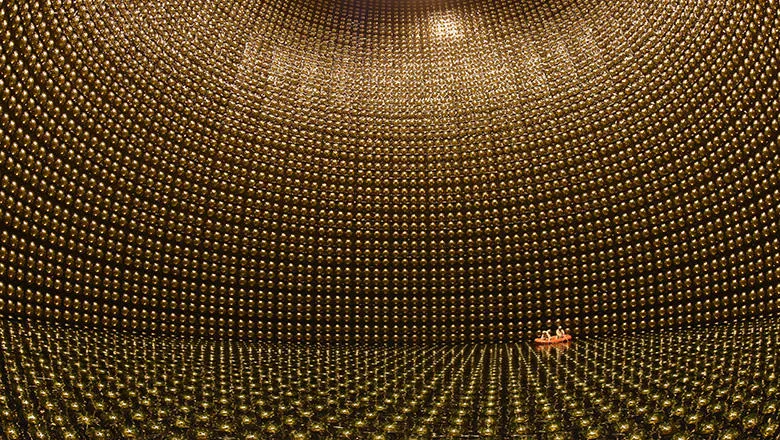Understanding if there is a difference between the behaviour of particles and antiparticles is a major goal of the science programme worldwide, as this can lead to understanding why matter dominates in the current universe. T2K is starting to narrow down whether there is a difference between neutrinos and antineutrinos, and how big it is, for the first time. This will be continued over the next few years by T2K with a more powerful beam, and will finally be continued by the next generation experiment that we have started to build - Hyper-Kamiokande - that is almost 10 times larger!
16 April 2020
King's physicists herald Big Bang breakthrough in particle physics
In the first breakthrough of its kind in over 50 years, a team of researchers from King’s Department of Physics have contributed to findings by an international research collaboration indicating that the matter-antimatter imbalance in the universe may be related to neutrinos

Research published in Nature this week highlights the first breakthrough of its kind in over 50 years – the Tokai-to Kamioka (T2K) group has found the first indication of a CP violation in neutral leptons (better known as neutrinos), shedding light on one of the universe's biggest mysteries - its imbalance of matter and antimatter.
The T2K neutrino oscillation experiment is based in Japan and involves a global team of over 300 scientists, including several from King’s College London, studying the properties of elementary particles called neutrinos. Dubbed ‘ghost particles’, neutrinos are similar to electrons but with no electrical charge – they are one of the most abundant particles in the universe and are extremely difficult to detect.
Results from the experiment were achieved by projecting a strong neutrino beam across a distance of 295 kilometres between Tokai and Kamioka (the east and west coasts of Japan, respectively). The beam, which produced zillions of neutrinos per second, was observed by a Super-Kamiokande detector (pictured, top) – a large water tank located 40 metres deep under a mountain. Prior to the group’s latest discovery, the Super-Kamiokande detector had facilitated the discovery of neutrino oscillations, and was awarded the co-shared 2015 Nobel prize in Physics.
Operation of the T2K experiment involved maintenance from King’s Experimental Particle & Astroparticle Physics (EPAP) group to an electromagnetic calorimeter – a neutrino detector which was designed, constructed and tested in the UK by the group, with particular focus on the data quality checking system. The group was also responsible for facilitating the analysis of neutrino oscillations by managing the input parameter simulations which were subsequently used to support findings by all members of the T2K experiment.

The importance of these findings is linked to one of the biggest mysteries in modern science – the ‘matter-antimatter imbalance’. Knowledge underpinning this is rooted in the Big Bang and understanding of the origin of matter and the universe. Scientists are in general agreement that the same amount of matter (particles) and antimatter (antiparticles) came into existence with the Big Bang. However, astrophysical observations confirm that antimatter is actually rare in our universe; everything around us is made up of simply matter, thus leading to a matter-antimatter imbalance. A turning point in the field occurred in 1964, when scientists discovered a tiny asymmetry in the behaviour of particles and antiparticles, called charge-conjugation and parity reversal (CP) symmetry violation. This was observed in the behaviour of quarks, one group of elementary particles. It was suggested that this could explain the matter-anti-matter imbalance of the universe, but at the time, those violations could not properly be observed and confirmed.
Consequently, the T2K group’s discovery of a CP violation in neutrinos is a significant step forward in particle physics – as the measured value of this CP violation in neutrinos appears larger than the CP violation in quarks. The group’s results indicate that the entire matter-antimatter imbalance in the universe may be related to neutrinos, though further data is needed to confirm this.
On T2K’s next steps, Professor Francesca Di Lodovico, Professor of Particle Physics in the Department of Physics, commented;
Francesca co-founded the UK branch of the T2K group in 2004. Other T2K participants at King’s and contributors to this research are Dr Jeanne Wilson, Reader in Particle Physics, Dr Teppei Katori, Reader, and postdoctoral researchers Dr Sophie King and Dr Stephane Zsoldos, all from the Experimental Particle & Astroparticle Physics (EPAP) group.
Read the full paper, Constraint on the Matter-Antimatter Symmetry-Violating Phase in Neutrino Oscillations on the Nature website.


